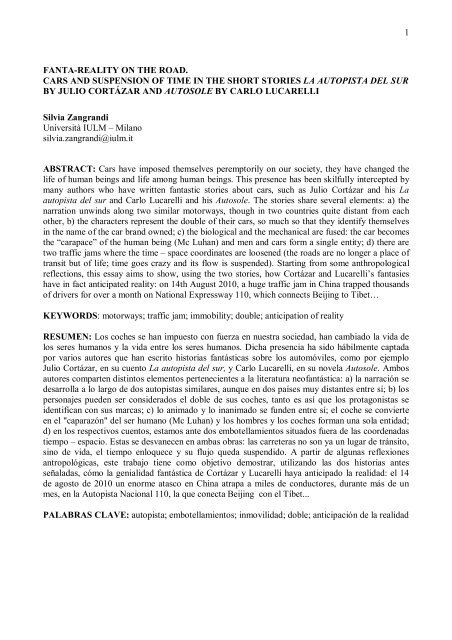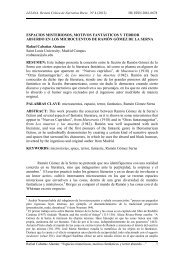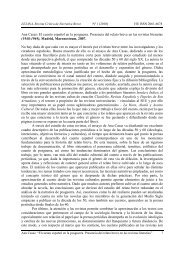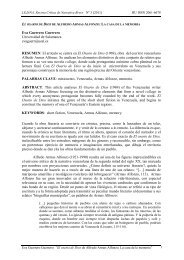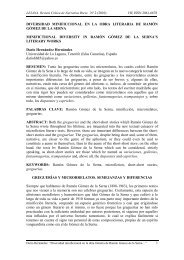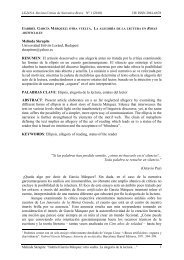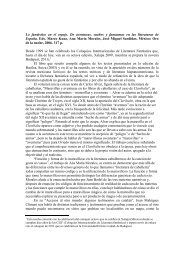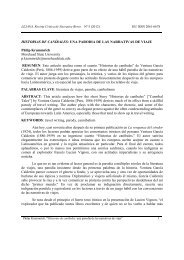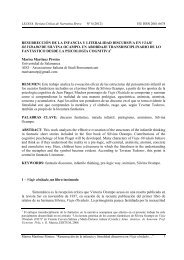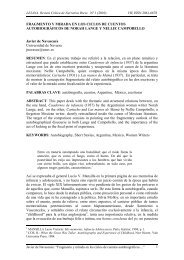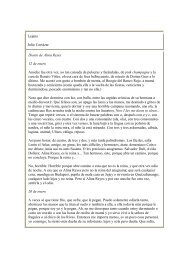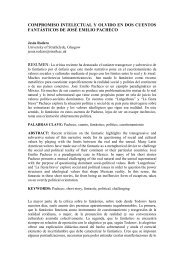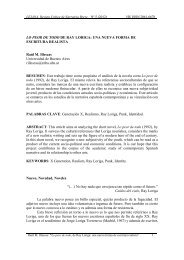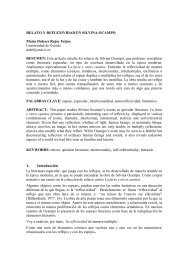1 fanta-reality on the road. cars and suspension of time in ... - Lejana
1 fanta-reality on the road. cars and suspension of time in ... - Lejana
1 fanta-reality on the road. cars and suspension of time in ... - Lejana
Create successful ePaper yourself
Turn your PDF publications into a flip-book with our unique Google optimized e-Paper software.
FANTA-REALITY ON THE ROAD.<br />
CARS AND SUSPENSION OF TIME IN THE SHORT STORIES LA AUTOPISTA DEL SUR<br />
BY JULIO CORTÁZAR AND AUTOSOLE BY CARLO LUCARELLI<br />
Silvia Zangr<strong>and</strong>i<br />
Università IULM – Milano<br />
silvia.zangr<strong>and</strong>i@iulm.it<br />
ABSTRACT: Cars have imposed <strong>the</strong>mselves peremptorily <strong>on</strong> our society, <strong>the</strong>y have changed <strong>the</strong><br />
life <strong>of</strong> human be<strong>in</strong>gs <strong>and</strong> life am<strong>on</strong>g human be<strong>in</strong>gs. This presence has been skilfully <strong>in</strong>tercepted by<br />
many authors who have written <str<strong>on</strong>g>fanta</str<strong>on</strong>g>stic stories about <strong>cars</strong>, such as Julio Cortázar <strong>and</strong> his La<br />
autopista del sur <strong>and</strong> Carlo Lucarelli <strong>and</strong> his Autosole. The stories share several elements: a) <strong>the</strong><br />
narrati<strong>on</strong> unw<strong>in</strong>ds al<strong>on</strong>g two similar motorways, though <strong>in</strong> two countries quite distant from each<br />
o<strong>the</strong>r, b) <strong>the</strong> characters represent <strong>the</strong> double <strong>of</strong> <strong>the</strong>ir <strong>cars</strong>, so much so that <strong>the</strong>y identify <strong>the</strong>mselves<br />
<strong>in</strong> <strong>the</strong> name <strong>of</strong> <strong>the</strong> car br<strong>and</strong> owned; c) <strong>the</strong> biological <strong>and</strong> <strong>the</strong> mechanical are fused: <strong>the</strong> car becomes<br />
<strong>the</strong> “carapace” <strong>of</strong> <strong>the</strong> human be<strong>in</strong>g (Mc Luhan) <strong>and</strong> men <strong>and</strong> <strong>cars</strong> form a s<strong>in</strong>gle entity; d) <strong>the</strong>re are<br />
two traffic jams where <strong>the</strong> <strong>time</strong> – space coord<strong>in</strong>ates are loosened (<strong>the</strong> <strong>road</strong>s are no l<strong>on</strong>ger a place <strong>of</strong><br />
transit but <strong>of</strong> life; <strong>time</strong> goes crazy <strong>and</strong> its flow is suspended). Start<strong>in</strong>g from some anthropological<br />
reflecti<strong>on</strong>s, this essay aims to show, us<strong>in</strong>g <strong>the</strong> two stories, how Cortázar <strong>and</strong> Lucarelli’s <str<strong>on</strong>g>fanta</str<strong>on</strong>g>sies<br />
have <strong>in</strong> fact anticipated <str<strong>on</strong>g>reality</str<strong>on</strong>g>: <strong>on</strong> 14th August 2010, a huge traffic jam <strong>in</strong> Ch<strong>in</strong>a trapped thous<strong>and</strong>s<br />
<strong>of</strong> drivers for over a m<strong>on</strong>th <strong>on</strong> Nati<strong>on</strong>al Expressway 110, which c<strong>on</strong>nects Beij<strong>in</strong>g to Tibet…<br />
KEYWORDS: motorways; traffic jam; immobility; double; anticipati<strong>on</strong> <strong>of</strong> <str<strong>on</strong>g>reality</str<strong>on</strong>g><br />
RESUMEN: Los coches se han impuesto c<strong>on</strong> fuerza en nuestra sociedad, han cambiado la vida de<br />
los seres humanos y la vida entre los seres humanos. Dicha presencia ha sido hábilmente captada<br />
por varios autores que han escrito historias fantásticas sobre los automóviles, como por ejemplo<br />
Julio Cortázar, en su cuento La autopista del sur, y Carlo Lucarelli, en su novela Autosole. Ambos<br />
autores comparten dist<strong>in</strong>tos elementos pertenecientes a la literatura ne<strong>of</strong>antástica: a) la narración se<br />
desarrolla a lo largo de dos autopistas similares, aunque en dos países muy distantes entre sí; b) los<br />
pers<strong>on</strong>ajes pueden ser c<strong>on</strong>siderados el doble de sus coches, tanto es así que los protag<strong>on</strong>istas se<br />
identifican c<strong>on</strong> sus marcas; c) lo animado y lo <strong>in</strong>animado se funden entre sí; el coche se c<strong>on</strong>vierte<br />
en el "caparazón" del ser humano (Mc Luhan) y los hombres y los coches forman una sola entidad;<br />
d) en los respectivos cuentos, estamos ante dos embotellamientos situados fuera de las coordenadas<br />
tiempo – espacio. Estas se desvanecen en ambas obras: las carreteras no s<strong>on</strong> ya un lugar de tránsito,<br />
s<strong>in</strong>o de vida, el tiempo enloquece y su flujo queda suspendido. A partir de algunas reflexi<strong>on</strong>es<br />
antropológicas, este trabajo tiene como objetivo demostrar, utiliz<strong>and</strong>o las dos historias antes<br />
señaladas, cómo la genialidad fantástica de Cortázar y Lucarelli haya anticipado la realidad: el 14<br />
de agosto de 2010 un enorme atasco en Ch<strong>in</strong>a atrapa a miles de c<strong>on</strong>ductores, durante más de un<br />
mes, en la Autopista Naci<strong>on</strong>al 110, la que c<strong>on</strong>ecta Beij<strong>in</strong>g c<strong>on</strong> el Tíbet...<br />
PALABRAS CLAVE: autopista; embotellamientos; <strong>in</strong>movilidad; doble; anticipación de la realidad<br />
1
Background<br />
Eccomi dunque su questa autostrada che<br />
ho percorso cent<strong>in</strong>aia di volte […] mi<br />
sembra d’aver perduto il senso dello<br />
spazio e quello del tempo<br />
(Italo Calv<strong>in</strong>o 118)<br />
Cars have imposed <strong>the</strong>mselves peremptorily <strong>on</strong> our society, <strong>the</strong>y have changed <strong>the</strong> life <strong>of</strong> human<br />
be<strong>in</strong>gs <strong>and</strong> life am<strong>on</strong>g human be<strong>in</strong>gs, <strong>the</strong>y are <strong>the</strong> means that make it possible to move, to live, to<br />
experience newness itself. Their speed seduces <strong>and</strong> fasc<strong>in</strong>ates, it gives us <strong>the</strong> possibility to go<br />
everywhere, to change space <strong>and</strong> <strong>time</strong>. Even, for Bar<strong>the</strong>s, it has become a “magic object”: “je crois<br />
que l’automobile est aujourd’hui l’équivalent assez exact des gr<strong>and</strong>es cathédrales gothiques: je veux<br />
dire une gr<strong>and</strong>e créati<strong>on</strong> d’époque [...] c<strong>on</strong>sommée dans s<strong>on</strong> image [...] par un peuple entier qui<br />
s’approprie en elle un objet parfaitement magique” (Bar<strong>the</strong>s 50). By speak<strong>in</strong>g about a new model <strong>of</strong><br />
Citroën, Bar<strong>the</strong>s claims that <strong>the</strong> car “est le meilleur messager de la surnature: il y a facilement dans<br />
l’objet une perfecti<strong>on</strong> et [...] un silence qui appartient à l’ordre du merveilleux” (Bar<strong>the</strong>s 150). The<br />
associati<strong>on</strong> between <strong>cars</strong> <strong>and</strong> magical aspects has been <strong>in</strong>tercepted by many narrators who have<br />
written <str<strong>on</strong>g>fanta</str<strong>on</strong>g>stic stories about <strong>cars</strong>. By start<strong>in</strong>g from purely real data, which every<strong>on</strong>e has<br />
experienced at least <strong>on</strong>ce <strong>in</strong> <strong>the</strong>ir life, <strong>the</strong>y have created stories which lead to <strong>the</strong> Fantastic.<br />
Introducti<strong>on</strong> to <strong>the</strong> two stories<br />
In 1966 Julio Cortázar publishes <strong>the</strong> short story La autopista del Sur regard<strong>in</strong>g a hyperbolic <strong>and</strong><br />
improbable motorway traffic jam. 1 In 1998 Carlo Lucarelli, very famous <strong>in</strong> Italy for his spy stories,<br />
publishes a book entitled Autosole 2 whose outcome is halfway between a novel (<strong>in</strong> fact, <strong>the</strong>re is a<br />
comm<strong>on</strong> story which l<strong>in</strong>ks <strong>the</strong> narrati<strong>on</strong>) <strong>and</strong> a collecti<strong>on</strong> <strong>of</strong> short stories. The two stories share<br />
several elements: a) <strong>the</strong> narrati<strong>on</strong> unw<strong>in</strong>ds al<strong>on</strong>g two similar motorways, though <strong>in</strong> two countries<br />
quite distant as far apart, b) <strong>the</strong>re are two traffic jams where <strong>the</strong> coord<strong>in</strong>ates <strong>of</strong> space <strong>and</strong> <strong>time</strong> are<br />
loosened (<strong>the</strong> <strong>road</strong>s are no l<strong>on</strong>ger a place <strong>of</strong> transit but <strong>of</strong> life; <strong>time</strong> goes crazy <strong>and</strong> its flow is<br />
suspended); c) <strong>the</strong> characters represent <strong>the</strong> double <strong>of</strong> <strong>the</strong>ir <strong>cars</strong>, so much so that <strong>the</strong>y identify<br />
<strong>the</strong>mselves <strong>in</strong> <strong>the</strong> name <strong>of</strong> <strong>the</strong> car br<strong>and</strong> owned; d) <strong>the</strong> biological <strong>and</strong> <strong>the</strong> mechanical are fused: <strong>the</strong><br />
car becomes <strong>the</strong> “carapace” <strong>of</strong> <strong>the</strong> human be<strong>in</strong>g, as McLuhan said, <strong>and</strong> human be<strong>in</strong>g <strong>and</strong> <strong>cars</strong> form<br />
a s<strong>in</strong>gle entity.<br />
Cortázar <strong>and</strong> Lucarelli deal with daily problems <strong>of</strong> traffic <strong>and</strong> translate <strong>the</strong>m <strong>in</strong>to narrative<br />
occasi<strong>on</strong>s. Us<strong>in</strong>g a term dear to Marc Augé, for both writers, <strong>the</strong> motorway is a “n<strong>on</strong> lieu de la<br />
surmodernité” which swallows <strong>time</strong>, space <strong>and</strong> identity. Before <strong>the</strong> reader’s eyes characters, whose<br />
existence is an<strong>on</strong>ymous <strong>and</strong> who live <strong>in</strong> a present without <strong>time</strong> <strong>and</strong> out <strong>of</strong> <strong>the</strong> History, parade. Their<br />
characters have <strong>on</strong>ly <strong>on</strong>e <str<strong>on</strong>g>reality</str<strong>on</strong>g> l<strong>in</strong>ked to movement or to its negati<strong>on</strong>, <strong>and</strong> to <strong>the</strong> atta<strong>in</strong>ment <strong>of</strong> <strong>the</strong><br />
dest<strong>in</strong>ati<strong>on</strong>. The plots <strong>of</strong> both stories are spare <strong>and</strong> used as a pretext. For <strong>the</strong> two writers <strong>the</strong><br />
motorway represents <strong>the</strong> ideal background for <strong>the</strong> stag<strong>in</strong>g <strong>of</strong> a story <strong>of</strong> sociological k<strong>in</strong>d where<br />
represent<strong>in</strong>g <strong>the</strong> relati<strong>on</strong>ship am<strong>on</strong>g <strong>the</strong> characters entrapped <strong>on</strong> <strong>the</strong> motorway. As Bacht<strong>in</strong> claims,<br />
1 It is not <strong>the</strong> first <strong>time</strong> s<strong>in</strong>ce Cortázar has set his narrati<strong>on</strong>s <strong>on</strong> a motorway; <strong>in</strong> fact, <strong>in</strong> 1983 he publishes Los<br />
aut<strong>on</strong>autas de la cosmopista, a trip without <strong>time</strong> from Paris to Marseille.<br />
2 To be precise, <strong>in</strong> August 1997 Lucarelli was asked to write a story every day for a m<strong>on</strong>th for <strong>the</strong> daily<br />
newspaper l’«Unità». These articles were <strong>in</strong> part collected <strong>in</strong> a book whose title is Autosole.<br />
2
<strong>the</strong> <strong>road</strong> is <strong>the</strong> meet<strong>in</strong>gs place par excellence. On <strong>the</strong> <strong>road</strong> <strong>the</strong> travell<strong>in</strong>g <strong>in</strong> <strong>the</strong> <strong>time</strong> <strong>and</strong> <strong>in</strong> <strong>the</strong> space<br />
<strong>of</strong> <strong>the</strong> most different people is <strong>in</strong>tertw<strong>in</strong>ed with o<strong>the</strong>r people <strong>in</strong> a certa<strong>in</strong> po<strong>in</strong>t <strong>in</strong> <strong>the</strong> <strong>time</strong> <strong>and</strong> <strong>in</strong> <strong>the</strong><br />
space (Bacht<strong>in</strong> 93). In <strong>the</strong> story by Cortázar, <strong>the</strong> drivers organize <strong>the</strong>mselves to be able to face<br />
several problems, as <strong>the</strong> supply <strong>of</strong> food <strong>and</strong> water, assist<strong>in</strong>g people who feel bad <strong>and</strong> even <strong>the</strong><br />
management <strong>of</strong> <strong>the</strong> dead. As Cortázar said <strong>in</strong> an <strong>in</strong>terview, he wishes to illustrate “el signo mas<br />
negativo de nuestra triste sociedad en la que vivimos, una especie de c<strong>on</strong>tradicción c<strong>on</strong> la vida<br />
humana, decir una especie de busqueda de la desgracia, de la <strong>in</strong>felicidad, de la exasperación a<br />
través de la gran maravilla tecnológica que es la automobil que debería darnos la liberdad”<br />
(www.youtube.com - Entrevista a Cortázar). On <strong>the</strong> c<strong>on</strong>trary, Lucarelli’s drivers seem not to have<br />
problems <strong>of</strong> surviv<strong>in</strong>g <strong>in</strong> <strong>the</strong> jam (<strong>the</strong>y d<strong>on</strong>’t look for food or water) but, similarly to Cortázar’s<br />
story, we are given an accurate representati<strong>on</strong> from a sociological po<strong>in</strong>t <strong>of</strong> view: we meet rich<br />
bus<strong>in</strong>essmen, ab<strong>and</strong><strong>on</strong>ed fiancées, families with children, disabled people, thieves who are<br />
escap<strong>in</strong>g, penniless boys who would like to reach <strong>the</strong>ir resorts… Every<strong>on</strong>e must try to solve a<br />
problem, which is always a relati<strong>on</strong>al sen<strong>time</strong>ntal type, <strong>the</strong> jam is fur<strong>the</strong>r complicat<strong>in</strong>g. In both we<br />
assist <strong>in</strong> <strong>the</strong> passive acceptance <strong>of</strong> <strong>the</strong> event, as if it were normal <strong>in</strong> some periods <strong>of</strong> <strong>the</strong> year (<strong>in</strong><br />
fact, we are <strong>in</strong> August). What ast<strong>on</strong>ishes us is <strong>the</strong> fact that Cortázar <strong>and</strong> Lucarelli’s <str<strong>on</strong>g>fanta</str<strong>on</strong>g>sies have <strong>in</strong><br />
fact anticipated <str<strong>on</strong>g>reality</str<strong>on</strong>g>: <strong>on</strong> 14th August 2010, a huge traffic jam <strong>in</strong> Ch<strong>in</strong>a trapped thous<strong>and</strong>s <strong>of</strong><br />
drivers for over a m<strong>on</strong>th <strong>on</strong> Nati<strong>on</strong>al Expressway 110, which c<strong>on</strong>nects Beij<strong>in</strong>g to Tibet… As <strong>in</strong><br />
Cortázar’s story, <strong>the</strong> Ch<strong>in</strong>ese drivers had to organize <strong>the</strong>mselves <strong>in</strong> order to survive, <strong>the</strong>y created a<br />
sales network <strong>of</strong> basic products, <strong>the</strong>y formed a sort <strong>of</strong> society similar to <strong>the</strong> <strong>on</strong>e <strong>the</strong>y came from.<br />
The same happens <strong>in</strong> Cortázar’s story, whose evident metaphorical <strong>and</strong> allegorical functi<strong>on</strong> is to<br />
show how <strong>the</strong> society created by <strong>the</strong> drivers reflects <strong>the</strong> c<strong>on</strong>diti<strong>on</strong>s which generated it. However, it<br />
is useful to remark that, when this moti<strong>on</strong>less society gets back <strong>in</strong>to gear, as mysteriously as it<br />
stopped, <strong>the</strong> ethical value <strong>of</strong> <strong>the</strong> old sense <strong>of</strong> solidarity, friendship <strong>and</strong> love dissolves as at <strong>the</strong> end<br />
<strong>of</strong> a pretence which has precise norms we can not c<strong>on</strong>travene. As <strong>in</strong> Lucarelli’s story, <strong>the</strong> motorway<br />
<strong>of</strong> <strong>the</strong> Ch<strong>in</strong>ese <str<strong>on</strong>g>reality</str<strong>on</strong>g> becomes <strong>the</strong> emblem <strong>of</strong> our daily life: speed, risk, sudden blocks which put a<br />
stra<strong>in</strong> <strong>on</strong> us.<br />
Space<br />
La autopista del sur described by Cortazar is <strong>the</strong> motorway which leads to Paris pass<strong>in</strong>g through<br />
F<strong>on</strong>ta<strong>in</strong>ebleau <strong>and</strong> <strong>on</strong> Sundays <strong>in</strong> August is <strong>of</strong>ten blocked by traffic; <strong>the</strong> motorway where<br />
Lucarelli’s story takes place is called A1 Milano-Napoli, also known as Autosole, 3 <strong>and</strong> <strong>in</strong> August<br />
(period when most Italian people leave for <strong>the</strong>ir holidays) is <strong>of</strong>ten c<strong>on</strong>gested by traffic. Differently<br />
from <strong>the</strong> <strong>road</strong>, <strong>the</strong> motorway has always been c<strong>on</strong>sidered not a place <strong>of</strong> meet<strong>in</strong>g but an<br />
<strong>in</strong>frastructure for <strong>the</strong> fast shipp<strong>in</strong>g, alien to its surround<strong>in</strong>g, to <strong>the</strong> l<strong>and</strong>scape (which is <strong>of</strong>ten marred<br />
by its presence) <strong>and</strong> to <strong>the</strong> people who travel: it is without identity. In Adorno’s op<strong>in</strong>i<strong>on</strong>, <strong>the</strong><br />
motorway has no expressi<strong>on</strong>, it ignores <strong>the</strong> shadows <strong>of</strong> steps <strong>and</strong> wheels (51). On <strong>the</strong> c<strong>on</strong>trary, <strong>in</strong><br />
Cortázar <strong>and</strong> Lucarelli’s stories <strong>the</strong> motorway loses its an<strong>on</strong>ymity: for some characters it becomes a<br />
place for meet<strong>in</strong>gs, life, love; for o<strong>the</strong>rs it is <strong>the</strong> symbol <strong>of</strong> solitude without isolati<strong>on</strong>; for every<strong>on</strong>e it<br />
is no more <strong>the</strong> place <strong>of</strong> movement but <strong>the</strong> place <strong>of</strong> <strong>the</strong> forced immobility. In a paradoxical,<br />
hyperbolic <strong>and</strong>, as <strong>in</strong> Lucarelli’s, <strong>in</strong> a certa<strong>in</strong> sense amus<strong>in</strong>g situati<strong>on</strong> <strong>the</strong> two stories take place.<br />
They start from a real event, precisely <strong>the</strong> traffic jam, but so<strong>on</strong> <strong>the</strong> <strong>time</strong>-space coord<strong>in</strong>ates skip <strong>and</strong><br />
<strong>the</strong> motorway becomes a place where nei<strong>the</strong>r circulati<strong>on</strong> nor communicati<strong>on</strong> exist. Lucarelli<br />
3 See Menduni, Enrico. L’Autostrada del Sole. Bologna: Il Mul<strong>in</strong>o, 1999 to master <strong>the</strong> story <strong>of</strong> <strong>the</strong><br />
Autostrada del Sole, whose c<strong>on</strong>structi<strong>on</strong>, started <strong>in</strong> 1956, marked <strong>the</strong> “Italian ec<strong>on</strong>omic miracle” <strong>and</strong><br />
changed <strong>the</strong> percepti<strong>on</strong> <strong>of</strong> <strong>the</strong> Italian geography.<br />
3
anthropomorphises <strong>the</strong> motorway: “L’autostrada diventa un serpente dalle scaglie fitte, che<br />
lentamente si allunga, si stende, abbagliante di riflessi” (7. My translati<strong>on</strong>: “<strong>the</strong> motorway becomes<br />
a snake with thick scales, which slowly stretches, with dazzl<strong>in</strong>g reflecti<strong>on</strong>s”). The metaphor<br />
referr<strong>in</strong>g to <strong>the</strong> <strong>cars</strong> <strong>in</strong> <strong>the</strong> queue, similar to a snake, is used several <strong>time</strong>s: “un serpente dalle scaglie<br />
fitte, che attende immobile sotto al sole rovente, respir<strong>and</strong>o piano” (9. My translati<strong>on</strong>: “a snake with<br />
thick scales which waits, still, under <strong>the</strong> hot sun, breath<strong>in</strong>g slowly”); “il serpente di metallo […]<br />
riprende lentamente a muoversi” (19. My translati<strong>on</strong>: “<strong>the</strong> metal snake […] starts aga<strong>in</strong> to move<br />
slowly”). Lucarelli trespasses <strong>in</strong> <strong>the</strong> field <strong>of</strong> visual images. In <strong>the</strong> words <strong>of</strong> Sklovski, with his<br />
images he means to transfer <strong>the</strong> object from its usual percepti<strong>on</strong> <strong>in</strong>to <strong>the</strong> sphere <strong>of</strong> a new percepti<strong>on</strong>,<br />
as to say an orig<strong>in</strong>al sematic variati<strong>on</strong> (Sklovski 5). Let’s read this very visual descripti<strong>on</strong>: “vista<br />
dall’alto, l’autostrada sembra un fiume nero attraversato da un branco di pesciol<strong>in</strong>i di tutte le forme.<br />
Il sole si riflette sulla lamiera delle capotte come sulle squame dei pesci e brilla, blu oltremare, nero<br />
nacré, verde mar<strong>in</strong>o, rosso ferrari, bianco metallizzato. Un arlecch<strong>in</strong>o di lamiera rovente” (104. My<br />
translati<strong>on</strong>: “seen from above, <strong>the</strong> motorway looks like a black river crossed by a shoal <strong>of</strong> small fish<br />
<strong>of</strong> all forms. The sun reflects <strong>on</strong> <strong>the</strong> sheet hoods like <strong>on</strong> <strong>the</strong> scale <strong>of</strong> fish <strong>and</strong> sh<strong>in</strong>es, blue<br />
ultramar<strong>in</strong>e, black nacre, sea green, red Ferrari, white metal. A harlequ<strong>in</strong> <strong>of</strong> hot sheet metal”). In<br />
order to <strong>in</strong>crease <strong>the</strong> visibility, Lucarelli uses chormatisms, similes <strong>and</strong> metaphors. Thanks to<br />
similes, <strong>the</strong> sense skips towards <strong>the</strong> surreal <strong>and</strong> <strong>the</strong> grotesque: la “coda pazzesca […] sta<br />
strangol<strong>and</strong>o l’autostrada” (37. My translati<strong>on</strong>: <strong>the</strong> “crazy queue […] is strangl<strong>in</strong>g <strong>the</strong> motorway”);<br />
“<strong>the</strong> motorway is obstructed worse than <strong>the</strong> arteries <strong>of</strong> an octogenarian” (my translati<strong>on</strong>:<br />
“l’autostrada <strong>in</strong>tasata peggio delle arterie di un ottantenne”, 41); “la coda […] li fa arrancare a<br />
s<strong>in</strong>ghiozzo sull’autostrada” (49. My translati<strong>on</strong>: “<strong>the</strong> <strong>cars</strong> queu<strong>in</strong>g <strong>on</strong> <strong>the</strong> motorway are struggl<strong>in</strong>g<br />
uphill <strong>on</strong> a stop-<strong>and</strong>-start”); “l’autostrada […] si muove […] al ritmo lento di un respiro” (65. My<br />
translati<strong>on</strong>: “<strong>the</strong> motorway […] moves to <strong>the</strong> slow rhythm <strong>of</strong> a breath”).<br />
S<strong>in</strong>ce for ever ficti<strong>on</strong> has had <strong>the</strong> task to reproduce <strong>in</strong>to itself <strong>the</strong> relati<strong>on</strong>ship with <strong>the</strong> world, to<br />
represent it, to suggest <strong>the</strong> object to present through a l<strong>in</strong>guistic devise <strong>and</strong> to draw it. Accord<strong>in</strong>g to<br />
Wunenburger, <strong>the</strong> image is <strong>the</strong> c<strong>on</strong>crete representati<strong>on</strong> <strong>of</strong> a material or c<strong>on</strong>ceptual object which is<br />
present or absent from a perceptive po<strong>in</strong>t <strong>of</strong> view <strong>and</strong> which enterta<strong>in</strong>s a relati<strong>on</strong>ship with its<br />
referent so to be able to represent <strong>and</strong> to recognize <strong>and</strong> identify by <strong>the</strong> m<strong>in</strong>d (Wunenburger 5). The<br />
practical translati<strong>on</strong> <strong>of</strong> this statement is <strong>in</strong> <strong>the</strong> images <strong>of</strong> <strong>the</strong> jam given by Cortázar: “todo era olor a<br />
gasol<strong>in</strong>a […] brillo del sol rebot<strong>and</strong>o en los cristales y en los bordes cromados, y para colmo la<br />
sensación c<strong>on</strong>tradictoria del encierro en plena selva de máqu<strong>in</strong>as pensadas para correr” (506) <strong>and</strong><br />
<strong>the</strong> queue is associated to a “caravana de camellos” (506). Lucarelli associates <strong>the</strong> motorway to a<br />
snake, Cortázar to a river: “la c<strong>in</strong>ta blanca del macadam c<strong>on</strong> su río <strong>in</strong>móvil de vehículos” (510).<br />
Both Cortázar <strong>and</strong> Lucarelli dedicate several moments to <strong>the</strong> descripti<strong>on</strong> <strong>of</strong> <strong>the</strong> <strong>cars</strong> queu<strong>in</strong>g: el<br />
“horiz<strong>on</strong>te de techos de automóviles” (Cortázar 508) is described by Cortázar <strong>in</strong> this way: “el 404<br />
del <strong>in</strong>geniero ocupaba el segundo lugar de la pista de la derecha c<strong>on</strong>t<strong>and</strong>o desde la franja divisoría<br />
de las dos pistas, c<strong>on</strong> lo cual tenía otros cuatro autos a su derecha y siete a su izquierda, aunque de<br />
hecho sólo pudiera ver dist<strong>in</strong>tamente los ocho coches que lo rodeaban” (506); “las doce filas se<br />
movían prácticamente en bloque, come si un gendarme <strong>in</strong>visible en el f<strong>on</strong>do de la autopista<br />
ordenara el avance simultáneo s<strong>in</strong> que nadie pudiese obtener ventajas” (508). The <strong>cars</strong> queu<strong>in</strong>g<br />
described by Lucarelli produce <strong>the</strong> dreamlike visi<strong>on</strong> <strong>of</strong> a mechanical l<strong>and</strong>scape: “luci rosse e gialle<br />
che frenano, rallentano e piano piano si fermano […] le auto sfilano lungo i f<strong>in</strong>estr<strong>in</strong>i, sembrano<br />
tornare <strong>in</strong>dietro e poi ripassano avanti, lentissime. […] le luci gialle e rosse riprend<strong>on</strong>o a<br />
lampeggiare e lentamente, senza speranza, il movimento si blocca” (9, 11. My translati<strong>on</strong>: “red <strong>and</strong><br />
yellow lights brake, slow down <strong>and</strong> little by little stop […] <strong>the</strong> <strong>cars</strong> parad<strong>in</strong>g al<strong>on</strong>g <strong>the</strong> w<strong>in</strong>dows,<br />
seem to come back <strong>and</strong> <strong>the</strong>n to pass aga<strong>in</strong> very slowly […] <strong>the</strong> red <strong>and</strong> yellow lights start aga<strong>in</strong> to<br />
flash <strong>and</strong> slowly, hopeless, <strong>the</strong> movement stops”); <strong>the</strong> <strong>cars</strong> move “a passo d’uomo, disposti su tre<br />
4
corsie diverse come carte mescolate a caso da uno che n<strong>on</strong> sa giocare» (101. My translati<strong>on</strong>: “at a<br />
walk<strong>in</strong>g pace, <strong>on</strong> three different queues, similar to cards r<strong>and</strong>om mixed by a pers<strong>on</strong> who can’t<br />
play”).<br />
Time<br />
The revoluti<strong>on</strong>ary c<strong>on</strong>cept <strong>of</strong> “entropy change” shown by <strong>the</strong> physician Rudolf Clausius who, <strong>in</strong><br />
1865, spoke about <strong>the</strong> <strong>in</strong>crease or decrease <strong>of</strong> <strong>the</strong> degree <strong>of</strong> disorder <strong>in</strong> a complex system, can help<br />
us to underst<strong>and</strong> what is happen<strong>in</strong>g to <strong>the</strong> characters <strong>of</strong> <strong>the</strong> two stories: accord<strong>in</strong>g to Clausius, every<br />
transformati<strong>on</strong> <strong>of</strong> a system leads to an <strong>in</strong>crease <strong>of</strong> entropy (as to say, <strong>of</strong> disorder) <strong>of</strong> <strong>the</strong> same<br />
system. We could say that <strong>the</strong> universe is made <strong>in</strong> such a way that each system evolves <strong>in</strong>exorably<br />
from ordered states to more <strong>and</strong> more disordered states. In fact, <strong>in</strong> <strong>the</strong> two stories <strong>the</strong> writers present<br />
a situati<strong>on</strong> which passes from an ordered state (regular flux <strong>of</strong> traffic) to a disordered <strong>on</strong>e (jam <strong>and</strong><br />
block <strong>of</strong> movement). 4 Cortázar <strong>and</strong> Lucarelli <strong>of</strong>fer <strong>the</strong> percepti<strong>on</strong> <strong>of</strong> a <strong>time</strong> “o<strong>the</strong>r”, rescued from<br />
human c<strong>on</strong>venti<strong>on</strong>s. The two stories open <strong>in</strong> medias res: <strong>the</strong> two motorways are plunged <strong>in</strong>to <strong>cars</strong>,<br />
<strong>the</strong> characters are already queu<strong>in</strong>g. We know exactly how l<strong>on</strong>g <strong>the</strong> jam told by Lucarelli lasts (it is<br />
<strong>in</strong>dicated from <strong>the</strong> title <strong>of</strong> <strong>the</strong> first <strong>and</strong> <strong>of</strong> <strong>the</strong> last chapter: “Autosole, 1st August”, “Autosole, 31st<br />
August”), while <strong>in</strong> Cortázar’s story <strong>the</strong> <strong>time</strong> length <strong>of</strong> <strong>the</strong> jam is not precise (“no atardecía nunca, la<br />
vibración del sol sobre la pista […] dilataba el vértigo”, 506) <strong>and</strong> <strong>the</strong> climatic changes <strong>in</strong>dicate <strong>the</strong><br />
flow <strong>of</strong> <strong>time</strong> (we pass from <strong>the</strong> summer heat <strong>of</strong> a Sunday afterno<strong>on</strong>, to <strong>the</strong> w<strong>in</strong>ter with snow <strong>and</strong> ice,<br />
to <strong>the</strong> spr<strong>in</strong>g). In this period passengers <strong>and</strong> <strong>the</strong>ir <strong>cars</strong> organize <strong>the</strong>mselves to f<strong>in</strong>d food <strong>and</strong> water,<br />
to assist people who feel bad <strong>and</strong> even to manage <strong>the</strong> dead.<br />
Our world, our life can not even be c<strong>on</strong>ceived apart from <strong>the</strong> c<strong>on</strong>cept <strong>of</strong> <strong>time</strong> as a sequence <strong>of</strong><br />
events which can not be reproduced. Time is with space <strong>the</strong> essential comp<strong>on</strong>ent <strong>of</strong> every human<br />
representati<strong>on</strong>: we can not know any objects without relat<strong>in</strong>g <strong>the</strong>m to space <strong>and</strong> <strong>time</strong>. Accord<strong>in</strong>g to<br />
Aristotle, <strong>time</strong> exists <strong>on</strong>ly as a factor <strong>in</strong>herent to movement, as “passio motus, <strong>in</strong> a similar<br />
relati<strong>on</strong>ship with matter (movement) <strong>and</strong> accident (<strong>time</strong>)”. On <strong>the</strong> base <strong>of</strong> this mean<strong>in</strong>g <strong>of</strong> <strong>the</strong> <strong>time</strong><br />
as passio motus, which appears <strong>in</strong> a fragment <strong>of</strong> <strong>the</strong> Physics by Aristotle, from a metaphysical po<strong>in</strong>t<br />
<strong>of</strong> view, <strong>time</strong> has not an <strong>in</strong>dependent existence but must necessarily <strong>in</strong>here to motus <strong>in</strong> order to exist<br />
(Ghisalberti 72).<br />
Also for Tommaso d’Aqu<strong>in</strong>o <strong>time</strong> has its base <strong>in</strong> movement, as to say <strong>in</strong> <strong>the</strong> first <strong>and</strong> <strong>the</strong>n <strong>of</strong> <strong>the</strong><br />
moti<strong>on</strong> itself. 5 In <strong>the</strong> Commentary to <strong>the</strong> Book IV <strong>of</strong> his Fisica, Tommaso highlights <strong>the</strong> more<br />
4 In <strong>the</strong>se last years studies from a physical po<strong>in</strong>t <strong>of</strong> view about <strong>the</strong> creati<strong>on</strong> <strong>of</strong> jams have been made. In <strong>the</strong><br />
n° 10 <strong>of</strong> <strong>the</strong> «New Journal <strong>of</strong> Physics» (march 2008) a team <strong>of</strong> Japanese scholars presented a research project<br />
entitled Traffic jams without bottlenecks – experimental evidence for <strong>the</strong> physical mechanism <strong>of</strong> <strong>the</strong><br />
formati<strong>on</strong> <strong>of</strong> a jam. I quote from <strong>the</strong> abstract: “A traffic jam <strong>on</strong> a highway is a very familiar phenomen<strong>on</strong>.<br />
From <strong>the</strong> physical viewpo<strong>in</strong>t, <strong>the</strong> system <strong>of</strong> vehicular flow is a n<strong>on</strong>-equilibrium system <strong>of</strong> <strong>in</strong>teract<strong>in</strong>g<br />
particles (vehicles). The collective effect <strong>of</strong> <strong>the</strong> many-particle system <strong>in</strong>duces <strong>the</strong> <strong>in</strong>stability <strong>of</strong> a free flow<br />
state caused by <strong>the</strong> enhancement <strong>of</strong> fluctuati<strong>on</strong>s, <strong>and</strong> <strong>the</strong> transiti<strong>on</strong> to a jamm<strong>in</strong>g state occurs sp<strong>on</strong>taneously<br />
if <strong>the</strong> average vehicle density exceeds a certa<strong>in</strong> critical value. Thus, a bottleneck is <strong>on</strong>ly a trigger <strong>and</strong> not <strong>the</strong><br />
essential orig<strong>in</strong> <strong>of</strong> a traffic jam. In this paper, we present <strong>the</strong> first experimental evidence that <strong>the</strong> emergence<br />
<strong>of</strong> a traffic jam is a collective phenomen<strong>on</strong> like `dynamical' phase transiti<strong>on</strong>s <strong>and</strong> pattern formati<strong>on</strong> <strong>in</strong> a n<strong>on</strong>equilibrium<br />
system. We have performed an experiment <strong>on</strong> a circuit to show <strong>the</strong> emergence <strong>of</strong> a jam with no<br />
bottleneck. In <strong>the</strong> <strong>in</strong>itial c<strong>on</strong>diti<strong>on</strong>, all <strong>the</strong> vehicles are mov<strong>in</strong>g, homogeneously distributed <strong>on</strong> <strong>the</strong> circular<br />
<strong>road</strong>, with <strong>the</strong> same velocity. The average density <strong>of</strong> <strong>the</strong> vehicles is prepared for <strong>the</strong> <strong>on</strong>set <strong>of</strong> <strong>the</strong> <strong>in</strong>stability.<br />
Even a t<strong>in</strong>y fluctuati<strong>on</strong> grows larger <strong>and</strong> <strong>the</strong>n <strong>the</strong> homogeneous movement cannot be ma<strong>in</strong>ta<strong>in</strong>ed. F<strong>in</strong>ally, a<br />
jam cluster appears <strong>and</strong> propagates backward like a solitary wave with <strong>the</strong> same speed as that <strong>of</strong> a jam cluster<br />
<strong>on</strong> a highway” (http://iopscience.iop.org/1367-2630/10/3/033001/fulltext, 11 july 2011).<br />
5 See Tommaso d’Aqu<strong>in</strong>o, <strong>in</strong> I Sent, 19, 5, 1.<br />
5
characteristic structural datum <strong>of</strong> temporality, as to say <strong>the</strong> directi<strong>on</strong> man attributes to <strong>time</strong>, by<br />
<strong>in</strong>terpret<strong>in</strong>g it accord<strong>in</strong>g to <strong>the</strong> categories oriented from <strong>the</strong> past to <strong>the</strong> future, from birth to death<br />
(Ghislaberti 73). Therefore, human be<strong>in</strong>gs recognize <strong>the</strong>mselves as subject to <strong>time</strong>. Every<strong>on</strong>e lives<br />
<strong>and</strong> perceives <strong>the</strong> flow <strong>of</strong> <strong>time</strong>; this percepti<strong>on</strong> is helped by elementary phenomena such as <strong>the</strong><br />
successi<strong>on</strong> <strong>of</strong> days <strong>and</strong> seas<strong>on</strong>s, <strong>the</strong> awareness <strong>of</strong> our own ag<strong>in</strong>g when we look <strong>in</strong> <strong>the</strong> mirror...<br />
Never<strong>the</strong>less, when we have to def<strong>in</strong>e what <strong>time</strong> is, words fail. Sant’Agost<strong>in</strong>o <strong>in</strong> Le c<strong>on</strong>fessi<strong>on</strong>i<br />
w<strong>on</strong>dered: “what’s <strong>time</strong>? Who could expla<strong>in</strong> it <strong>in</strong> a pla<strong>in</strong> <strong>and</strong> short form? if nobody questi<strong>on</strong>s me, I<br />
know; if I liked to expla<strong>in</strong> it to whom is questi<strong>on</strong><strong>in</strong>g me, I d<strong>on</strong>’t know”. The questi<strong>on</strong> <strong>of</strong> temporality<br />
summ<strong>on</strong>s who formulates it, his habits <strong>of</strong> thought, his language, <strong>the</strong> same organizati<strong>on</strong> <strong>of</strong> <strong>the</strong> world<br />
<strong>and</strong> his different philosophies <strong>of</strong> Time which have alternated. In <strong>the</strong> op<strong>in</strong>i<strong>on</strong> <strong>of</strong> <strong>the</strong> Italian physician<br />
Giuseppe L<strong>on</strong>go, <strong>the</strong> fracture between percepti<strong>on</strong> <strong>and</strong> rati<strong>on</strong>al descripti<strong>on</strong> <strong>of</strong> <strong>time</strong> is a relatively<br />
recent phenomen<strong>on</strong>. He claims that temporality is c<strong>on</strong>f<strong>in</strong>ed to mere illusi<strong>on</strong> where <strong>the</strong>re’s nei<strong>the</strong>r<br />
space for man nor for his apparent freedom <strong>of</strong> thought <strong>and</strong> acti<strong>on</strong>. The man, unpredictable <strong>and</strong><br />
subject to <strong>the</strong> mutability <strong>of</strong> fate, becomes a deformed <strong>and</strong> alien creature to <strong>the</strong> predictable Universe<br />
where he lives (http://people.na.<strong>in</strong>fn.it/~l<strong>on</strong>go/). The asserti<strong>on</strong>s here quoted reflect <strong>in</strong> <strong>the</strong> two<br />
stories: <strong>the</strong> passio motus is at <strong>the</strong> base <strong>of</strong> <strong>the</strong> flow<strong>in</strong>g <strong>of</strong> <strong>the</strong> days <strong>on</strong> <strong>the</strong> motorway; <strong>the</strong> days <strong>and</strong> <strong>the</strong><br />
events told are oriented, as Tommaso d’Aqu<strong>in</strong>o suggests, from <strong>the</strong> past to <strong>the</strong> future, from birth to<br />
death. Anyway, <strong>in</strong> <strong>the</strong> two stories <strong>the</strong> temporality is c<strong>on</strong>f<strong>in</strong>ed to mere illusi<strong>on</strong>: it seems impossible<br />
to Lucarelli’s drivers that a m<strong>on</strong>th has passed, as <strong>on</strong> <strong>the</strong> c<strong>on</strong>trary <strong>the</strong> c<strong>on</strong>venti<strong>on</strong>al <strong>in</strong>struments as <strong>the</strong><br />
calendar clock <strong>and</strong> <strong>the</strong> motorway toll ticket state; Cortázar’s characters <strong>in</strong>sist <strong>in</strong> va<strong>in</strong> to measure <strong>the</strong><br />
<strong>time</strong> or <strong>the</strong>y d<strong>on</strong>’t care for it, becom<strong>in</strong>g <strong>in</strong> this way deformed <strong>and</strong> alien creatures. Cortázar speaks<br />
about <strong>time</strong> several <strong>time</strong>s, start<strong>in</strong>g from <strong>the</strong> very beg<strong>in</strong>n<strong>in</strong>g: “Al pr<strong>in</strong>cipio la muchacha del Dauph<strong>in</strong>e<br />
había <strong>in</strong>sistido en llevar la cuenta del tiempo, aunque al <strong>in</strong>geniero del Peugeot 404 le daba ya lo<br />
mismo. Cualquiera podía mirar su reloj pero era como si ese tiempo atado a la muñeca derecha o el<br />
bip bip de la radio midieran otra cosa, fuera el tiempo de los que no han hecho la estupidez de<br />
querer regresar a París por la autopista del sur un dom<strong>in</strong>go de tarde” (505); “ya ni valía la pena<br />
mirar el reloj pulsera para perderse en cálculos <strong>in</strong>útiles” (506); “las horas acababan por<br />
superp<strong>on</strong>erse, por ser siempre la misma en el recuerdo” (509). At first, <strong>the</strong> jam is lived as an <strong>of</strong>fense<br />
to <strong>on</strong>e’s own pride, <strong>in</strong> fact for some<strong>on</strong>e “el embotellamiento era una afrenta exclusivamente<br />
pers<strong>on</strong>al” (510), some<strong>on</strong>e compla<strong>in</strong>s “porque le parecía un atropello someter a millares de pers<strong>on</strong>as<br />
a un regime de caravana de camellos” (506); <strong>the</strong>n, little by little, <strong>the</strong> drivers submit to <strong>the</strong> situati<strong>on</strong><br />
<strong>and</strong> organize <strong>the</strong>mselves to fr<strong>on</strong>t <strong>the</strong> adversities which will appear dur<strong>in</strong>g <strong>the</strong>ir forced stop. Once<br />
<strong>the</strong> jam vanishes as mysteriously as it was created, <strong>the</strong> runn<strong>in</strong>g <strong>of</strong> <strong>the</strong> <strong>cars</strong> starts aga<strong>in</strong> <strong>and</strong> <strong>the</strong> story<br />
ends <strong>in</strong> <strong>the</strong> speed. The drivers d<strong>on</strong>’t know <strong>the</strong> reas<strong>on</strong> <strong>of</strong> <strong>the</strong> hurry: “no se podía hacer otra cosa que<br />
ab<strong>and</strong><strong>on</strong>arse a la marcha, adaptarse mecánicamente a la velocidad de los autos que lo rodeaban, no<br />
pensar […] s<strong>in</strong> que ya se supiera f<strong>in</strong> por qué tanto apuro, por qué esa carrera en la noche entre autos<br />
desc<strong>on</strong>osidos d<strong>on</strong>de nadie sabía nada de los otros, d<strong>on</strong>de todo el mundo miraba fijamente hacia<br />
adelante, exclusivamente hacia adelante” (522-523). This statement shows <strong>the</strong> behaviour <strong>of</strong> <strong>the</strong><br />
modern-direct human be<strong>in</strong>g who simply fits mechanically <strong>and</strong> abstractly <strong>in</strong>to what surrounds him,<br />
look<strong>in</strong>g fixedly forward <strong>in</strong> a solipsism which precludes <strong>the</strong> relati<strong>on</strong>ship with <strong>the</strong> o<strong>the</strong>rs. In<br />
Lucarelli’s story we have <strong>the</strong> impressi<strong>on</strong> that s<strong>in</strong>ce <strong>the</strong> beg<strong>in</strong>n<strong>in</strong>g <strong>the</strong> drivers are already prepared to<br />
face <strong>the</strong> queue. In fact, apart from <strong>the</strong> man <strong>on</strong> board <strong>the</strong> blue Bravo, who looks at his watch<br />
<strong>in</strong>sistently because he has two meet<strong>in</strong>gs (<strong>on</strong>e be<strong>in</strong>g a hot date), <strong>and</strong> <strong>the</strong> man who has just d<strong>on</strong>e a<br />
robbery <strong>and</strong> wishes to arrive so<strong>on</strong> because he has been wounded by a security guard, all <strong>the</strong> o<strong>the</strong>r<br />
characters accept <strong>the</strong> queue, dem<strong>on</strong>strat<strong>in</strong>g that <strong>in</strong> August it is normal to have it as a travel<br />
compani<strong>on</strong> <strong>and</strong> <strong>the</strong> narrati<strong>on</strong> forgets to <strong>in</strong>form about <strong>the</strong> flux <strong>of</strong> <strong>time</strong> <strong>and</strong> devotes itself to <strong>the</strong><br />
exam<strong>in</strong>ati<strong>on</strong> <strong>of</strong> <strong>the</strong> characters <strong>and</strong> <strong>the</strong>ir private life. The motorway, or better, as Lucarelli’s<br />
describes it, “un serpente dalle scaglie fitte, che […] attende, immobile sotto il sole, respir<strong>and</strong>o<br />
6
piano” (7. My translati<strong>on</strong>: “a snake with thick scales which […] waits under <strong>the</strong> hot sun breath<strong>in</strong>g<br />
slowly”) is <strong>the</strong> metaphor <strong>of</strong> <strong>the</strong> universe where different pers<strong>on</strong>alities cohabit, with <strong>the</strong>ir wishes,<br />
<strong>the</strong>ir c<strong>on</strong>tradicti<strong>on</strong>s, <strong>the</strong> problems that life poses every day. Only <strong>in</strong> <strong>the</strong> two f<strong>in</strong>al chapters Lucarelli<br />
rem<strong>in</strong>ds us that <strong>the</strong> characters who tell <strong>the</strong> stories are trapped <strong>in</strong> a jam. In fact, <strong>the</strong> last but <strong>on</strong>e<br />
chapter ends <strong>in</strong> this way: “improvvisamente, la fila si muove […] l’autostrada sembra un serpente<br />
dalle scaglie lum<strong>in</strong>ose, senza testa e senza coda, che si stira e si allunga, come se si fosse svegliato<br />
<strong>in</strong> quel momento. Talmente compatto che n<strong>on</strong> lascia neppure <strong>in</strong>travedere la trama nera dell’asfalto<br />
sotto le squame colorate (103. My translati<strong>on</strong>: “suddenly <strong>the</strong> queue moves […] <strong>the</strong> motorway seems<br />
a snake with bright scales, without head or tail, which stretches as if it has awaken <strong>in</strong> that moment.<br />
So compact that it doesn’t even allow to glimpse <strong>the</strong> black texture <strong>of</strong> <strong>the</strong> asphalt under its coloured<br />
scales”). The metaphor motorway-universe appears <strong>in</strong> all its evidence <strong>in</strong> <strong>the</strong> last passage. Here all<br />
<strong>the</strong> <strong>cars</strong> with <strong>the</strong>ir human cargo are presented at <strong>the</strong> start<strong>in</strong>g parade. It seems that <strong>the</strong> queue has<br />
stopped <strong>and</strong> every<strong>on</strong>e asks: “what is happen<strong>in</strong>g?”. Almost awaken<strong>in</strong>g from a l<strong>on</strong>g sleep, <strong>the</strong> drivers<br />
lean out <strong>of</strong> <strong>the</strong> w<strong>in</strong>dows try<strong>in</strong>g to see what has caused <strong>the</strong> jam. Some<strong>on</strong>e tries to give an answer:<br />
maybe an accident, maybe <strong>the</strong> <strong>road</strong> works, but <strong>the</strong> more real answer is <strong>the</strong> colloquial “Boh” (108.<br />
My translati<strong>on</strong>: “no idea”). Here <strong>the</strong> questi<strong>on</strong> <strong>of</strong> every<strong>on</strong>e regard<strong>in</strong>g <strong>the</strong> future <strong>and</strong> <strong>the</strong> unknown is<br />
subtended. “El Diablo riesce a vedere solo f<strong>in</strong>o alla prima curva, dove c’è Rambo che vede solo<br />
f<strong>in</strong>o alla galleria” (108. My translati<strong>on</strong>: “El Diablo can see <strong>on</strong>ly up to <strong>the</strong> first curve where Rambo<br />
is, who can see <strong>on</strong>ly up to <strong>the</strong> tunnel”). The percepti<strong>on</strong> <strong>of</strong> <strong>the</strong> pass<strong>in</strong>g <strong>of</strong> <strong>the</strong> <strong>time</strong> has fallen <strong>in</strong>to<br />
c<strong>on</strong>fusi<strong>on</strong>: when <strong>the</strong> man <strong>in</strong> <strong>the</strong> Mercedes, who “gli sembra di essere fermo <strong>in</strong> coda da una vita”<br />
(109. My translati<strong>on</strong>: “th<strong>in</strong>ks he has been stopp<strong>in</strong>g all his life”) looks at <strong>the</strong> calendar clock <strong>on</strong> his<br />
Rolex, which <strong>in</strong>dicates 31 st August, <strong>and</strong> compares it to <strong>the</strong> motorway toll ticket, which <strong>in</strong>dicates 1 st<br />
August, <strong>the</strong> panic explodes. To his “it’s not possible” echoes <strong>the</strong> “it’s not possible” <strong>of</strong> <strong>the</strong> boy <strong>in</strong> <strong>the</strong><br />
P<strong>and</strong>a. But what is really puzzl<strong>in</strong>g are <strong>the</strong> last words <strong>of</strong> <strong>the</strong> story which kick <strong>of</strong>f any possible<br />
c<strong>on</strong>clusi<strong>on</strong>: “Cosa succede qu<strong>and</strong>o f<strong>in</strong>iamo la benz<strong>in</strong>a? […] e che succede se n<strong>on</strong> la f<strong>in</strong>iamo mai<br />
più?” (109. My translati<strong>on</strong>: “What will it happen when we run out <strong>of</strong> petrol? […] <strong>and</strong> what will it<br />
happen if it never runs out?”).<br />
The c<strong>on</strong>clusi<strong>on</strong> <strong>of</strong> both stories is emblematic. Lucarelli’s drivers can’t see where <strong>the</strong> queue f<strong>in</strong>ishes.<br />
It is so l<strong>on</strong>g that it mixes up with <strong>the</strong> horiz<strong>on</strong>. Therefore, <strong>the</strong> central questi<strong>on</strong> about <strong>the</strong> human<br />
existence was born: what happens later?. Similarly Cortázar’s drivers ask <strong>the</strong> reas<strong>on</strong>s for <strong>the</strong>ir<br />
c<strong>on</strong>t<strong>in</strong>uous moti<strong>on</strong> <strong>and</strong> <strong>the</strong>y can’t f<strong>in</strong>d <strong>the</strong> answer <strong>in</strong> <strong>the</strong> o<strong>the</strong>r drivers because <strong>the</strong>y are <strong>in</strong> turn<br />
closed <strong>in</strong> <strong>the</strong>ir own lives <strong>and</strong> look fixedly forward, without th<strong>in</strong>k<strong>in</strong>g, suffer<strong>in</strong>g <strong>the</strong> moti<strong>on</strong>.<br />
Identificati<strong>on</strong> car-human be<strong>in</strong>g<br />
In <strong>the</strong> two stories here exam<strong>in</strong>ed <strong>the</strong> characters are identified with <strong>the</strong> name <strong>of</strong> <strong>the</strong> car br<strong>and</strong> <strong>the</strong>y<br />
are driv<strong>in</strong>g: <strong>in</strong> La autopista del sur <strong>the</strong> characters are recognized as Peugeot 404, BMW, Dauph<strong>in</strong>e,<br />
2CV, “Floride, como se divertían en llamarlo los chicos del Simca” (Cortázar 516) <strong>and</strong> so <strong>on</strong>. The<br />
animate mixes with <strong>the</strong> <strong>in</strong>animate, human be<strong>in</strong>g <strong>and</strong> car become <strong>on</strong>e; let’s read this fragment:<br />
“Taunus les ordenó a gritos que volvieran a sus coches […] Estir<strong>and</strong>o el brazo izquierdo el 404<br />
buscó la mano de Dauph<strong>in</strong>e […] 404 miró enternecido y deslumbrado a su izquierda busc<strong>and</strong>o los<br />
ojos de Dauph<strong>in</strong>e” (Cortázar 520-521). In Autosole people are associated to <strong>the</strong> car <strong>the</strong>y drive, <strong>in</strong><br />
fact we d<strong>on</strong>’t know <strong>the</strong>ir true names but we call <strong>the</strong>m by <strong>the</strong> name <strong>of</strong> <strong>the</strong> car br<strong>and</strong>: blue Bravo,<br />
blue 2CV, red Fiesta, silver Ka, white Tipo, white Scania, Mercedes 5000. The <strong>cars</strong> do not limit<br />
<strong>the</strong>mselves to lend <strong>the</strong>ir name to <strong>the</strong> owners, but <strong>the</strong>y transform <strong>the</strong>mselves <strong>in</strong> a lively mechanism,<br />
<strong>in</strong> vibrant <strong>and</strong> attractive bodies. As McLuhan claims, <strong>on</strong>ce men where terrorized by animals <strong>and</strong> for<br />
this reas<strong>on</strong> <strong>the</strong>y entered ritually <strong>and</strong> psychologically <strong>in</strong> <strong>the</strong> sk<strong>in</strong>s <strong>of</strong> <strong>the</strong> animals <strong>the</strong>y had captured;<br />
now men behave <strong>in</strong> <strong>the</strong> same way <strong>in</strong> respect <strong>of</strong> <strong>cars</strong> which scare <strong>and</strong> dom<strong>in</strong>ate <strong>the</strong>m (McLuhan 76).<br />
7
The car is built around <strong>the</strong> human be<strong>in</strong>gs who drive it, it wraps <strong>the</strong>m up <strong>and</strong> it completes <strong>the</strong>ir body,<br />
precisely it identifies with <strong>the</strong>m. In <strong>the</strong> case <strong>of</strong> Peugeot 404 by Cortázar <strong>and</strong> Mercedes 5000 by<br />
Lucarelli, <strong>the</strong> car becomes <strong>the</strong> symbol <strong>of</strong> social promoti<strong>on</strong>: Cortázar’s eng<strong>in</strong>eer, proudly c<strong>on</strong>scious<br />
<strong>of</strong> <strong>the</strong> charm <strong>of</strong> his car given by its dimensi<strong>on</strong>s, “<strong>of</strong>reció su coche, que llamaba burl<strong>on</strong>amente el<br />
wag<strong>on</strong>-lit, a quienes lo necesitaran” (513); <strong>the</strong> man <strong>in</strong> <strong>the</strong> Mercedes described by Lucarelli “ha la<br />
faccia di un uomo talmente fortunato che n<strong>on</strong> ha bisogno di sognare […] la Mercedes fa capire che<br />
s<strong>on</strong>o un uomo molto ricco, lo ammetto” (33-34. My translati<strong>on</strong>: <strong>the</strong> man “has <strong>the</strong> face <strong>of</strong> such a<br />
lucky man who doesn’t need to dream […] my Mercedes makes it clear I am a very rich man, I<br />
admit”). In fact, even a small mean <strong>of</strong> transport gives <strong>the</strong> c<strong>on</strong>crete sensati<strong>on</strong> <strong>of</strong> <strong>the</strong> <strong>in</strong>dividual<br />
ownership, <strong>of</strong> someth<strong>in</strong>g which is ours, which obeys to our orders: it helps our desire for<br />
omnipotence (Andre<strong>on</strong>i 69).<br />
The car is c<strong>on</strong>sidered a sort <strong>of</strong> decentralizati<strong>on</strong> <strong>of</strong> <strong>the</strong> house: to create <strong>in</strong>timacy, <strong>the</strong> eng<strong>in</strong>eer’s car<br />
has «las ventanillas tapadas por las l<strong>on</strong>as de la tienda» (Cortázar 518); <strong>the</strong> seat covers <strong>of</strong> <strong>the</strong> white<br />
Scania are “coprisedili come il perl<strong>in</strong>ato di una pizzeria” (Lucarelli 29. My translati<strong>on</strong>: “similar to<br />
<strong>the</strong> wooden upholstery <strong>of</strong> a pizzeria”). The items <strong>on</strong> <strong>the</strong> car as well witness <strong>the</strong> wish to reproduce<br />
<strong>the</strong> homel<strong>in</strong>ess <strong>and</strong> some t<strong>in</strong>sels resist: talismans, secular <strong>and</strong> religious images, teddy bears… Let’s<br />
read this passage by Lucarelli:<br />
“sul portell<strong>on</strong>e posteriore del TIR, la decalcomania del tipo che mostra il medio e dice tiè, s<strong>on</strong>o<br />
italiano! E più sotto la scritta a lettere mezze scollate del nome <strong>in</strong> codice per la radio cb: MACHO.<br />
Sui f<strong>in</strong>estr<strong>in</strong>i laterali della cab<strong>in</strong>a i poster di Moana Pozzi e Selen a gr<strong>and</strong>ezza naturale. Sul<br />
cruscotto, dietro una cornice di luci bianche, rosse e verdi […] una statua bianca e illum<strong>in</strong>ata della<br />
Mad<strong>on</strong>na col cuore trafitto” (29).<br />
(My translati<strong>on</strong>: “<strong>on</strong> <strong>the</strong> tailgate <strong>of</strong> <strong>the</strong> truck, a decal show<strong>in</strong>g <strong>the</strong> middle f<strong>in</strong>ger <strong>and</strong> <strong>the</strong> writ<strong>in</strong>g “I’m<br />
Italian!”. Below, <strong>the</strong> driver’s name MACHO. On <strong>the</strong> side w<strong>in</strong>dows some life-size posters <strong>of</strong> <strong>the</strong> two<br />
pornostars Selen <strong>and</strong> Moana Pozzi. On <strong>the</strong> dashboard, beh<strong>in</strong>d a frame <strong>of</strong> white, red <strong>and</strong> green lights<br />
[...] a white statue <strong>of</strong> Our Lady <strong>and</strong> a heart pierced”).<br />
The eng<strong>in</strong>eer’s discouragement <strong>in</strong> underst<strong>and</strong><strong>in</strong>g that, with <strong>the</strong> end <strong>of</strong> <strong>the</strong> jam, he has lost his new<br />
friends irremediably, is masterfully presented by Cortázar <strong>in</strong> <strong>the</strong> list <strong>of</strong> <strong>the</strong> objects that <strong>the</strong> owners<br />
have forgotten <strong>in</strong> different car-houses: “en el Volkswagen del soldado debía estar su chaqueta de<br />
cuero. Taunus tenía la novela que él había leído en los primeros días. Un frasco de lav<strong>and</strong>a casi<br />
vacío en el 2HP de las m<strong>on</strong>jas. Y él tenía ahí […] el osito de felpa que Dauph<strong>in</strong>e le había regalado<br />
como mascota” (522).<br />
At <strong>the</strong> end <strong>of</strong> <strong>the</strong> analysis <strong>of</strong> <strong>the</strong>se two stories it is clear how <strong>the</strong> forced paralysis <strong>in</strong>duces <strong>the</strong><br />
characters to rec<strong>on</strong>sider <strong>the</strong>ir own relati<strong>on</strong>ship with <strong>the</strong> o<strong>the</strong>rs, with <strong>the</strong> space which surrounds <strong>the</strong>m<br />
<strong>and</strong> with <strong>the</strong> <strong>time</strong> which marks <strong>the</strong>ir existence. In c<strong>on</strong>clusi<strong>on</strong>, <strong>the</strong> huge hyperbole that characterizes<br />
<strong>the</strong> jam becomes <strong>the</strong> metaphor <strong>of</strong> <strong>the</strong> technological society where we live (Brilli 125).<br />
BIBLIOGRAPHY<br />
ADORNO, Theodor Wiesengrund (1974; 1951): M<strong>in</strong>ima moralia; reflecti<strong>on</strong>s from damaged life.<br />
Translated from <strong>the</strong> German by E. F. N. Jephcott. L<strong>on</strong>d<strong>on</strong>: New Left Books.<br />
AUGE, Marc (1992) : N<strong>on</strong>-Lieux. Introducti<strong>on</strong> à une anthropologie de la surmodernité.<br />
Paris :Editi<strong>on</strong> du Seuil.<br />
BACHTIN, Michail (1993): Estétique et théorie du roman. Traduit par Daria Oliver. Paris:<br />
Gallimard.<br />
BARTHES, Rol<strong>and</strong> (1957; 1970) : Mythologies. Paris: Editi<strong>on</strong>s du Seuil.<br />
8
BRILLI, Attilio (1999): La vita che corre. Mitologia dell’automobile. Bologna: Il Mul<strong>in</strong>o.<br />
CALVINO, Italo (1990): Gli amori difficili. Milano: M<strong>on</strong>dadori.<br />
CORTÁZAR, Julio. Cuentos completos. Madrid: Alfaguara, 1994, vol. I, pp. 505-523.<br />
GHISALBERTI, Aless<strong>and</strong>ro. “Ontologia e logica della temporalità da Tommaso d’Aqu<strong>in</strong>o a<br />
Guglielmo di Ockham”. Filos<strong>of</strong>ia del Tempo. Ed. Luigi Ruggiu. Milano: Bruno M<strong>on</strong>dadori,<br />
1998. 72-86.<br />
LUCARELLI, Carlo (1998): Autosole. Milano: Rizzoli.<br />
Entrevista a Cortázar. La autopista del sur. C<strong>on</strong>sulted <strong>on</strong> 11 July 2011.<br />
.<br />
LONGO, Giuseppe. “Alcuni aspetti del tempo tra fisica e filos<strong>of</strong>ia ovvero alcune riflessi<strong>on</strong>i di un<br />
fisico su un problema antico come il tempo”. C<strong>on</strong>sulted <strong>on</strong> 11 July 2011.<br />
.<br />
McLUHAN, Marshall (1951): The Mechanical Bride. Folklore <strong>in</strong> Industrial Man. New York:<br />
Vanguard Press.<br />
MENDUNI, Enrico (1999): L’Autostrada del Sole. Bologna: Il Mul<strong>in</strong>o.<br />
SKLOVSKIJ, Victor (1965) : “Art as technique”. Russian Formalist criticism. Four essays,<br />
translated <strong>and</strong> with an <strong>in</strong>troducti<strong>on</strong> by Lee T. Lem<strong>on</strong> <strong>and</strong> Mari<strong>on</strong> J. Reis. L<strong>in</strong>coln, University<br />
<strong>of</strong> Nebraska Press, 3-24.<br />
WUNENBURGER, Jean Jacques (1997) : Philosophie des images. Paris: Presses Universitaires de<br />
France.<br />
9


